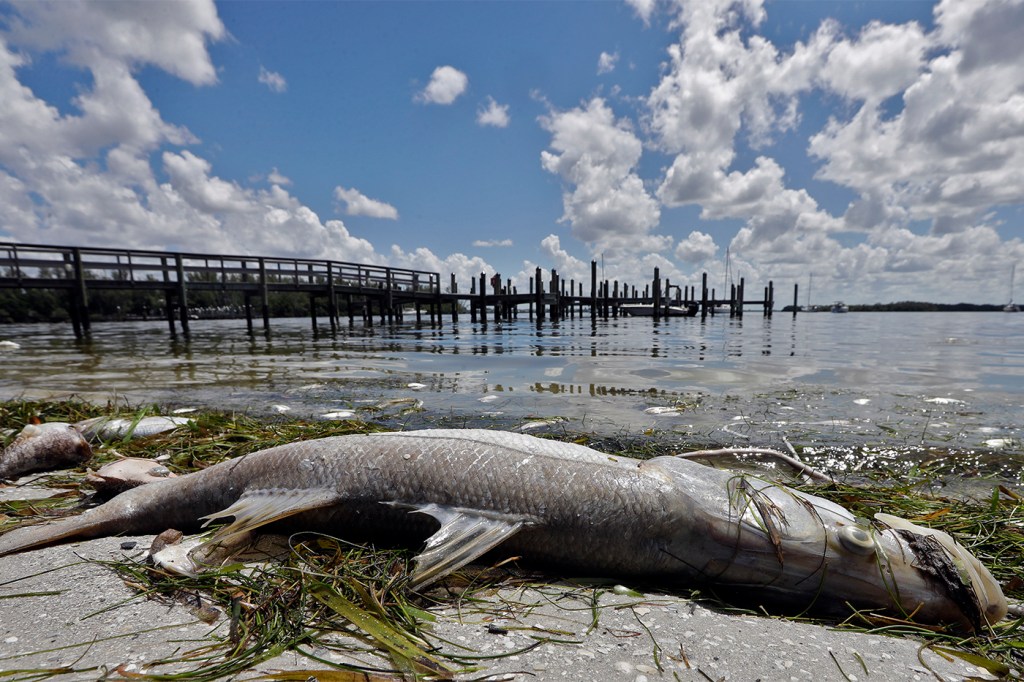What happens to sea life during hurricanes? Can they move to calmer waters? A marine scientist explains
Some marine animals will escape by going farther out to sea; however, others could perish along the beaches, says Mark Patterson, a professor at Northeastern’s Marine Science Center.

When hurricanes roar in, expect sharks to head out to sea, corals to shatter, and grouper and other reef fish to end up dead on shorelines.
Hurricane Milton was making its way across the Gulf of Mexico Wednesday and expected to make landfall in the Tampa Bay area on the west coast of Florida.
A big storm like Milton can be expected to churn the water 60 to 80 feet below the sea’s surface, says Mark Patterson, a professor at Northeastern’s Marine Science Center.
Some marine animals will be able to escape by going farther out to sea, he says.
The approaching megastorm may have already sent blacktip and hammerhead sharks that frequent Florida’s west coast swimming to calmer waters.
“A lot of fish do sense a disturbance like this and go to deeper water,” Patterson says.
That’s especially true for sharks, which do not have swim bladders that cause fish like snappers and groupers to maintain neutral buoyancy in water and hinder their escape, he says.
Sharks may also have a special sense that gives them a heads-up when a storm is on the way, says Shark Angels, a shark conservation organization.
Editor’s Picks
“There’s a growing body of research that suggests sharks can actually feel changes in barometric pressure — either through their inner ear or something called a lateral line,” the organization says.
Whales also have the ability to move quickly to calmer waters and “are not overly affected by hurricanes,” says the National Oceanic and Atmospheric Administration.
But bony fish with swim bladders take longer, hours or days, “to boogie out of the way,” Patterson says.
A hurricane like Milton can hurl reef fish like grouper and snapper 50 feet up from the depths and cause them to experience barotrauma, which is when their swim bladders expand on their ascent to the surface, leaving them too buoyant to descend again.
“They can end up on the beach” or swirling debris near the shoreline, Patterson says.
Sharks don’t regulate their buoyancy that way, he says.
But not all sharks choose to dodge big storms.
Tiger sharks, a large and robust species, remained in the shallow waters off the Bahamas despite a direct hit from Hurricane Matthew in 2016, and “nearly doubled in numbers shortly after the storm,” Shark Angels says.
“Tiger sharks aren’t picky eaters, so scientists suspect they were scavenging on dead animals left behind by the storm,” the organization says.
There have been plenty of hoaxed videos of sharks swimming in streets after storms, but the video of a finned animal swimming in a Fort Myers backyard after Hurricane Ian in 2022 was determined to be the real thing.
Experts just couldn’t figure out what kind of fish it was, although a young bull shark was one guess, according to the AP.
The impact on coral reefs
Hurricane force waves and underwater churn can smash coral reefs and strip the living tissue right off hard corals, Patterson says. He says that after a 1980 hurricane in Jamaica, he saw tissue ripped off corals in Discovery Bay from sea level down to 40 feet.
But storms can also help propagate staghorn coral by breaking branches into smaller spears that take root in the sand, he says, adding that that only works if the hurricanes aren’t too severe.
Most coral colonies in Florida are located in the Keys, which are not expected to take a direct hit from Milton, Patterson says.
The bayside targeted by Milton tends to have scattered, isolated corals including soft corals like sea fans that demonstrate greater resilience during storms than reef-building corals, he says.
“Sea fans can pull their polyps inside and hide better,” Patterson says. Less rigid and stiff than staghorn or elkhorn coral, they are better able to go with the flow of water, he says.
They could still be “blasted and killed by monster waves,” Patterson says. Sponges on the bayside might also be ripped up and destroyed if they do not find a good landing spot.
“Corals are a fragile symbiosis,” already stressed by global warming, disease and degraded water quality, Patterson says. “Now you hit them with an acute thing like a storm.”
The danger of storm runoff to marine life
The danger to sea life doesn’t pass when hurricanes exit the scene, Patterson says.
Storm runoff pouring back into the sea can degrade the already poor water quality of the Gulf of Mexico and create toxic algae blooms that kill fish and even threaten human life when aerosolized, Patterson says, adding that he knows of someone who succumbed to the airborne toxins.
Algae blooms kill fish in two main ways, by driving down the oxygen load in the water and releasing toxins that kill the fish outright, Patterson says.
He predicts that “nasty pathogens” such as Vibrio bacteria will emerge from the canals and overloaded septic tanks in the wake of Hurricane Milton.
As with algae blooms, the danger extends to humans as well as sea life. “It’s going to be toxic in many areas to go into the water if you’re a first responder,” Patterson says.












